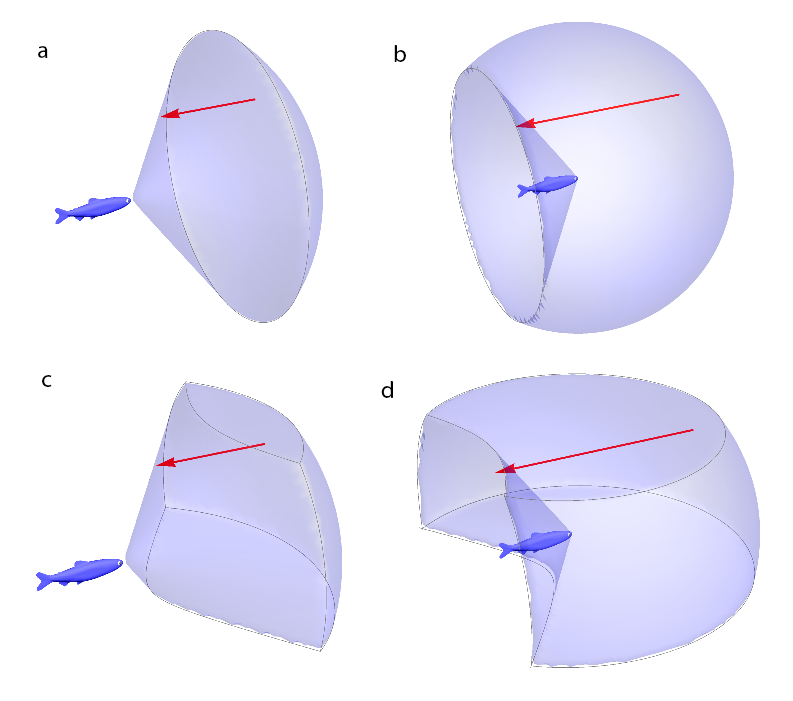We are a group of University of Georgia ecologists working on an Alaska-based project to better understand drift-feeding behavior, especially in juvenile Chinook salmon.
What is “drift feeding?”
Drift feeding is a behavior of fish in moving water that hold a steady position, facing upstream into the current, and dart back and forth to intercept passing items of food. The most well-known drift feeders are trout, but a large portion of stream fish species worldwide are drift feeders, as are many coral reef fishes. Many wild Chinook, Coho, and Atlantic salmon also spend a year or more as juveniles drift feeding in freshwater before migrating out to sea, and their success in this early life stage often makes the difference between strong and weak salmon runs when they return to spawn.
Why study drift feeding behavior?
Feeding behavior connects the energy intake of animals, which is crucial to their growth and survival, with the characteristics of their environment such as prey abundance, prey distribution, and water velocity. Mathematically modeling these behaviors helps us to carefully test hypotheses about how animals are affected by their habitat and by each other. Drift-feeding behavior is especially amenable to such modeling, because it is fairly repetitive–within a reasonable approximation, fish hold a steady position, at a steady water velocity, making the same kinds of motions over and over. But amenable doesn’t mean easy.
Why is a new understanding needed?
Ecologists have been modeling drift-feeding behavior since the 1980s, and current drift-feeding models have provided useful information for many fishery management decisions. Although they make more effective predictions than existing alternatives, multiple recent studies have shown that the machinery underlying our most detailed models of the drift feeding process is incorrect. The models rely on a set of assumed constraints about where, when, and how fish can detect and capture prey, but we now know the fish very rarely act according to these constraints.
We think we can explain drift-feeding behavior more accurately using a different set of constraints based on the knowledge that fish have limited “visual attention” — that just like every other animal, including humans, they cannot fully process all the information reaching their eyes at one time. We are building a detailed mathematical model of drift feeding around this core idea. We are also working on a simpler approximation of the model for some management applications. During 2015 and 2016, we will use field data and lab experiments to test our models.

Why study Chinook salmon, Arctic grayling, and dolly varden?
Juvenile Chinook salmon are our primary focus. Chinook populations are recently declining throughout Alaska, and our previous research identified stream flow and competition as likely factors influencing the productivity of Chinook populations, at least in interior Alaska. We will use the new models to better understand of how these factors and other habitat characteristics affect the success of juvenile Chinook salmon.
A major difficulty of studying the drift-feeding behavior of juvenile Chinook salmon is that our models predict behavior of fish individually, but these salmon in the wild are almost always found in schools, where competing fish affect each other’s behavior and the availability of prey. We therefore cannot test the models’ predictions for individual Chinook salmon in the wild, because another process (competition) is interfering with the processes we’re modeling.
To get around this problem, we are also studying Chinook salmon one-by-one in the lab, and we are studying the wild behavior of two other drift-feeding species that do feed individually, Arctic grayling and dolly varden. With these tools to validate the predictions of the model for individuals, we will be able to test the model on group predictions for Chinook salmon and gather valuable insights about how their habitat and competitors affect their energy intake.
For more information…
For more information about us, read about the People and Organizations involved in the Drift Model Project.
Scientists interested in much more technical detail about our project can find our Project Summary and Statement of Work on the website of our funding agency, the North Pacific Research Board.

One thought on “About the Project”
Comments are closed.